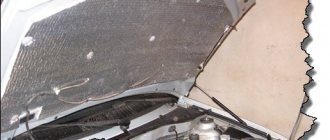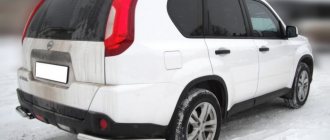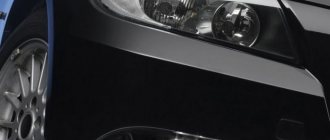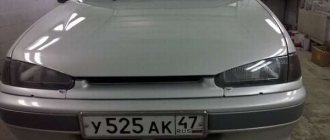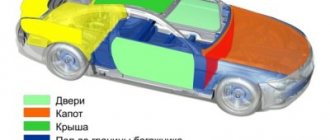This term has other meanings, see Hood.
Typical hood mount.
Alternative option.
Car bonnet
is a body part that protects the engine and other elements of the car’s engine compartment from the negative effects of external factors.
In a narrow sense, this is the cover of the engine compartment of a car. In the wide sense, a part of the body protruding in front of the car, usually with an engine[1].
In the vast majority of cases, the term is used in a narrow sense[2].
Device
In most cases, the hood is attached to the body on hinges and has a lock with a remote drive from a lever or handle located in the cabin or, less commonly, on the radiator grille. Ford used on some of its cars (Focus II, Mondeo III) a hood lock drive from a key, the keyhole for which was located behind the folding factory emblem on the radiator grille. The hinges can be located both in front (the hood opens against the direction of travel, tilting up and forward) and behind the hood (opens in the direction of travel, tilting up and back). The latter is more convenient, but requires a very reliable lock, since the hood can be opened while moving by the incoming air flow. On some cars, the hood opened to the side - for example, on the GAZ-12 ZIM it could be opened to the right or left (with the lock on the opposite side serving as a hinge), or even simply removed, for which it was necessary to open both locks at the same time.Until the mid-1930s, the hood on most cars consisted of two halves connected by a piano hinge, which opened to the side independently of each other. The hinge axis was fixed in the engine shield and on the radiator lining. Subsequently, the so-called “alligator” hoods, opening up and back, became widespread, which over time replaced hoods with two halves. “Alligator” hoods, due to weak locks, were prone to being opened by air flow while moving, so in the second half of the 1950s, so-called “safe” hoods with front hinges began to be used, which, when opened, folded up and forward. However, the inconvenience of access to the engine led to the return of rear-hinged hoods in the 1970s, now combined with more secure locks that prevent accidental opening while driving.
On budget cars, the hood usually has simple hinges and is secured in the open position by a folding strut. On more expensive models, there are spring-loaded hinges, which, when the lock is open, themselves lift the hood to the upper position and hold it in it, or gas stops that perform the same function.
On racing cars, as well as tuned ones that imitate them, the hood may not have hinges, but instead it is held in place with the help of long pins that fit into reciprocal recesses on the engine compartment shield, and external locks (the so-called “racing”) - in this case it is convenient to remove for maintenance, repair or replacement of the engine. In most countries, the operation of vehicles with such a hood mount is prohibited on public roads. In some cases, the entire front of the car is foldable, including the fenders and bumper, which in this case is usually made of fiberglass or carbon fiber for the purpose of lightness.
For carriage-type cars, the hood may be internal, accessible from the passenger compartment. For example, in the UAZ-452 it is a removable metal cap located between the driver and front passenger seats. In another case (most truck tractors), the entire cabin acts as a hood, tilting on hinges for access to the engine (which does not exclude the possibility of having a separate hood inside the cabin, used for adjustments and minor repairs).
For rear-engine cars, the hood is located at the rear of the body, and there is a trunk lid at the front. Rear-engine station wagons (for example, Volkswagen Typ 4 Variant) usually have an internal hood, accessible from the luggage compartment when the rear door is open. In some mid-engine cars and sidecars, access to the engine was provided from the passenger compartment by folding down the back of the rear seat.
The hood, as a clearly visible part of the front of a car, is often used to install various decorative elements - for example, a hood figure or an ornament in the form of the manufacturer's emblem. Its shape and design are influenced by the layout of the engine compartment and the design features of the power unit. For example, on low sports cars, as well as mass-produced models with a very large engine (for example, the Volga GAZ-24), a special stamping has to be done on the hood above the engine, which is sometimes styled as an air intake. Thanks to this, it is possible to combine sufficient height space for the engine with a low hood, providing good visibility from the driver’s seat. Much less commonly used is a real functional bonnet air intake, which serves to supply air to the engine under some pressure (inertial boost).
Windshield washer nozzles are located on the hoods of modern cars. The inside of the hood is often covered with a special sound-absorbing material - polymer (foamed plastic) or natural (usually felt). The rear of the hood acts as a spoiler, cutting off air flow from the recess in front of the windshield that houses the windshield wipers.
To protect the windshield and the front of the car, install a hood deflector. It is a plastic screen that follows the contours of the car hood. The functional purpose of the hood deflector is to protect the paint surface of the front of the car and the aerodynamic zone of the deflector screen shadow. Getting into the upper flow, small particles of dirt, flies, dust go around the hood and windshield without coming into contact with them. Even a small stone that hits the deflector is thrown higher than the car.
Hood locks are sometimes protected by anti-theft system elements located under the hood, that is, in the engine compartment. The main task of mechanical hood locks is to prevent unauthorized access to the engine compartment. The hood lock design usually consists of two parts. Control part - recognizes the control signal from an external electronic device or turning the key in the lock cylinder, and by moving the cable inside the casing it transmits the action to the lock part, blocking the standard lock or engaging with a specially installed metal “loop”.
Kinds
The hood cover is made of:
- Plastic
The plastic hood is popular among car enthusiasts due to its light weight, immunity to corrosion, and attractive appearance. At the same time, it also has a number of disadvantages, such as poor maintainability, susceptibility to high temperatures, and low strength.
- Carbona
The material is divided into dry and wet carbon. The carbon fiber hood has the advantages of attractive design, light weight and high strength. Thanks to this, it is an indispensable element of car tuning. The key disadvantage of a carbon body element is its cost.
Safety
In recent years, regulations have been introduced in Japan and Europe that set limits on the severity of injuries to a pedestrian's head when struck by a car. This leads to more advanced hood designs, such as the hood with an inner panel with small tapered recesses on the Mazda RX-8 and other cars. Other developments make the hood an active structure, so that in the event of a collision with a pedestrian, the hood pushes its surface a few centimeters away from the solid parts of the engine. This is achieved using mechanical (spring) or pyrotechnic devices. Development of a safe hood using a mechanical aluminum energy absorber is also underway.
New technologies
Modern models are equipped with a pedestrian protection system. Its essence lies in the fact that in the event of a collision between a car and a person, the engine compartment lid is slightly raised, which reduces the likelihood of a pedestrian receiving serious injuries. A person will not hit blunt objects located below the hood. Every 9 out of 800 cars are equipped with an active pedestrian protection hood.
The cover that protects the engine compartment of a vehicle plays not only a protective, but also an aesthetic role. The appearance of the vehicle depends on its condition.
Source
Notes
- [abvgd-auto.narod.ru/Slovo/kapot.htm Hood. A car enthusiast's primer abvgd-auto.narod.ru]
- [images.yandex.ru/yandsearch?text=%D0%9A%D0%B0%D0%BF%D0%BE%D1%82 You can see visually by Yandex’s responses to the “Hood” request in the “Pictures” section]
| p • o • p Car design | ||
| Car parts | ||
| Body | Frame | Platform • Wing • Body-on-frame • Bumper • Semi-convertible • Chassis • Spare tire • Crumple zones • Dagmar bumpers • Trunk roof • Fender • Side fenders • Radiator grille • Roof • Air intake • Monocoque • Body kit • Rack • Pontoon fenders • Rear wing • Shaker bucket • Spoiler • Subframe • Tonneau |
| Branches | Trunk • Hood | |
| Doors | Butterfly Wing Doors • Gull Wing Doors • Back Hinged Doors • Lambo Doors • Sliding Doors • Top Hung Doors | |
| Window | Greenhouse • Sunroof • Electric glass • Window • Windshield • Windshield wiper • Tinting | |
| Other | Carbfiller • Bumper sticker • Radiator figurine • Japan Black paint • Side window deflector • Running boards • Car tire • Tow hitch • Fifth wheel coupling • Branch guard | |
| Exterior equipment | Automotive lighting | Daytime Running Lights • Headlight • Hidden Lights • High Intensity Lamps • Reflector • Spotlight • Turn Signals |
| Identification marks and more | Vehicle Identification Number • License plates • Vanity plate • Parking aid • Anti-theft system • Windshield/windshield cleaner • Side mirrors | |
| Interior equipment | Driver sensors | Backup Camera • Turbocharger • Buzzer • Onborder • Electronic Instruments • Fuel Gauge • GPS and GPS Receiver • Head-Up Display • Warning Lights • Failure Indicator • Night Vision • Odometer • Radar Detector • High Beam Detector • Speedometer • Tachometer • Trip Computer |
| Control | Bowden cable • Cruise control • Electronic throttle control • Gearbox • Parking brake • Manettino dial • Car steering wheel • Choke • Manual control | |
| Anti-theft protection | Key • Car alarm • Immobilizer • Horn • Automatic vehicle location • VIN etching • Central locking | |
| Safety and seats | Airbag • Armrest • Automatic seat belts • Bench seat • Seat • Child lock • Mother-in-law's seat • Seat belt | |
| Other | Air conditioning • Ancillary power • Audio system • Car phone • Center console • Dashboard • Flat tire • Glove box • Power steering • Rear view mirror • Sun visor | |
| Creators | ||
| Automotive design firms | Bertone • BMC • Cardi • Castagna • Coggiola • Colani • DC Design • EDAG • Fioravanti • Ghia • Heuliez • IAD • I.DE.A • IED • ItalDesign • Karmann • Michelotti • Pininfarina • Rinspeed • Sbarro • Spada • Stola • Torino Design • Zagato • Zender | |
| Constructors | Giorgetto Giugiaro • Raymond Loewy • Alec Issigonis • Battista Farina “Pinin” • Vitaly Andreevich Grachev • Luigi Colani • Michael Mauer • Ferdinand Porsche • Enzo Ferrari | |
| See also: Automotive design | ||
Basic requirements for protection and rules for its installation
The crankcase protection must meet the following requirements:
Video: ProRoad Composite Crankcase Protection
To avoid unnecessary problems with installation, it is advisable to purchase original factory crankcase protection. They provide all the holes for fastening, service hatches and other elements that perfectly match the corresponding parts of the underbody of the car. They are also equipped with the necessary fastening elements. You can easily install this cover yourself by following these steps:
On some rear-wheel drive vehicles, it may be necessary to install two shields to protect the crankcase and to protect the transmission. When choosing engine crankcase protection for your car, pay attention to:
In any case, installing protection is a reliable guarantee of safe driving on broken roads and off-road.
Source
Excerpt characterizing the Hood (car)
Pursued by a hundred thousand French army under the command of Bonaparte, met by hostile inhabitants, no longer trusting their allies, experiencing a lack of food and forced to act outside all foreseeable conditions of war, the Russian army of thirty-five thousand, under the command of Kutuzov, hastily retreated down the Danube, stopping where it was overtaken by the enemy, and fought back with rearguard actions, only as much as was necessary in order to retreat without losing weight. There were cases at Lambach, Amsteten and Melk; but, despite the courage and fortitude, recognized by the enemy himself, with whom the Russians fought, the consequence of these affairs was only an even faster retreat. The Austrian troops, having escaped capture at Ulm and joined Kutuzov at Braunau, now separated from the Russian army, and Kutuzov was left only to his weak, exhausted forces. It was impossible to even think about defending Vienna any longer. Instead of an offensive, deeply thought-out, according to the laws of the new science - strategy, war, the plan of which was transferred to Kutuzov when he was in Vienna by the Austrian Gofkriegsrat, the only, almost unattainable goal that now seemed to Kutuzov was to, without destroying the army like Mack under Ulm, to connect with the troops coming from Russia. On October 28, Kutuzov and his army crossed to the left bank of the Danube and stopped for the first time, putting the Danube between themselves and the main forces of the French. On the 30th he attacked Mortier’s division located on the left bank of the Danube and defeated it. In this case, trophies were taken for the first time: a banner, guns and two enemy generals. For the first time after a two-week retreat, the Russian troops stopped and, after a struggle, not only held the battlefield, but drove out the French. Despite the fact that the troops were stripped, exhausted, weakened by one third, backward, wounded, killed and sick; despite the fact that the sick and wounded were left on the other side of the Danube with a letter from Kutuzov, entrusting them to the philanthropy of the enemy; despite the fact that the large hospitals and houses in Krems, converted into infirmaries, could no longer accommodate all the sick and wounded, despite all this, the stop at Krems and the victory over Mortier significantly raised the morale of the army. Throughout the entire army and in the main quarters, the most joyful, although unfair, rumors were circulating about the imaginary approach of columns from Russia, about some kind of victory won by the Austrians, and about the retreat of the frightened Bonaparte. Prince Andrei was during the battle with the Austrian general Schmitt, who was killed in this case. A horse was wounded under him, and he himself was slightly grazed in the arm by a bullet. As a sign of the special favor of the commander-in-chief, he was sent with news of this victory to the Austrian court, which was no longer in Vienna, which was threatened by French troops, but in Brunn. On the night of the battle, excited, but not tired (despite his weak-looking build, Prince Andrei could endure physical fatigue much better than the strongest people), having arrived on horseback with a report from Dokhturov to Krems to Kutuzov, Prince Andrei was sent that same night courier to Brunn. Sending by courier, in addition to rewards, meant an important step towards promotion. The night was dark and starry; the road turned black between the white snow that had fallen the day before, on the day of the battle. Now going over the impressions of the past battle, now joyfully imagining the impression that he would make with the news of victory, remembering the farewell of the commander-in-chief and comrades, Prince Andrei galloped in the mail chaise, experiencing the feeling of a man who had waited for a long time and had finally achieved the beginning of the desired happiness. As soon as he closed his eyes, the firing of rifles and cannons was heard in his ears, which merged with the sound of wheels and the impression of victory. Then he began to imagine that the Russians were fleeing, that he himself had been killed; but he quickly woke up, with happiness as if he learned again that none of this had happened, and that, on the contrary, the French had fled. He again remembered all the details of the victory, his calm courage during the battle and, having calmed down, dozed off... After the dark starry night, a bright, cheerful morning came. The snow melted in the sun, the horses galloped quickly, and new and varied forests, fields, and villages passed indifferently to the right and left. At one of the stations he overtook a convoy of Russian wounded. The Russian officer driving the transport, lounging on the front cart, shouted something, cursing the soldier with rude words. In the long German vans, six or more pale, bandaged and dirty wounded were shaking along the rocky road. Some of them spoke (he heard Russian dialect), others ate bread, the heaviest ones silently, with meek and painful childish sympathy, looked at the courier galloping past them. Prince Andrei ordered to stop and asked the soldier in what case they were wounded. “The day before yesterday on the Danube,” answered the soldier. Prince Andrei took out his wallet and gave the soldier three gold coins. “For everyone,” he added, turning to the approaching officer. “Get well, guys,” he addressed the soldiers, “there’s still a lot to do.” - What, Mr. Adjutant, what news? – the officer asked, apparently wanting to talk. - Good ones! “Forward,” he shouted to the driver and galloped on. It was already completely dark when Prince Andrei entered Brunn and saw himself surrounded by tall buildings, the lights of shops, house windows and lanterns, beautiful carriages rustling along the pavement and all that atmosphere of a large, lively city, which is always so attractive to a military man after the camp. Prince Andrei, despite the fast ride and sleepless night, approaching the palace, felt even more animated than the day before. Only the eyes sparkled with a feverish brilliance, and thoughts changed with extreme speed and clarity. All the details of the battle were vividly presented to him again, no longer vaguely, but definitely, in a condensed presentation, which he made in his imagination to Emperor Franz. He vividly imagined random questions that could be asked of him, and the answers that he would make to them. He believed that he would immediately be presented to the emperor. But at the large entrance of the palace an official ran out to him and, recognizing him as a courier, escorted him to another entrance. - From the corridor to the right; there, Euer Hochgeboren, [Your Highness,] you will find the adjutant on duty in the wing,” the official told him. - He takes you to the Minister of War. The adjutant on duty in the wing, who met Prince Andrei, asked him to wait and went to the Minister of War. Five minutes later, the aide-de-camp returned and, bending especially politely and letting Prince Andrei go ahead of him, led him through the corridor into the office where the Minister of War was working. The aide-de-camp, with his exquisite politeness, seemed to want to protect himself from the Russian adjutant’s attempts at familiarity. Prince Andrei's joyful feeling weakened significantly when he approached the door of the War Minister's office. He felt insulted, and the feeling of insult at that same moment, unnoticed by him, turned into a feeling of contempt, based on nothing. His resourceful mind at the same moment suggested to him the point of view from which he had the right to despise both the adjutant and the minister of war. “They must find it very easy to win victories without smelling gunpowder!” he thought. His eyes narrowed contemptuously; He entered the office of the Minister of War especially slowly. This feeling intensified even more when he saw the Minister of War sitting over a large table and for the first two minutes did not pay attention to the newcomer. The Minister of War lowered his bald head with gray temples between two wax candles and read, marking with a pencil, the papers. He finished reading without raising his head, when the door opened and footsteps were heard. “Take this and hand it over,” the Minister of War said to his adjutant, handing over the papers and not yet paying attention to the courier. Prince Andrei felt that either of all the affairs that occupied the Minister of War, the actions of Kutuzov’s army could least of all interest him, or it was necessary to let the Russian courier feel this. “But I don’t care at all,” he thought. The Minister of War moved the rest of the papers, aligned their edges with the edges and raised his head. He had a smart and characteristic head. But at the same moment as he turned to Prince Andrei, the intelligent and firm expression on the face of the Minister of War, apparently habitually and consciously changed: the stupid, feigned, not hiding his pretense, smile of a man who receives many petitioners one after another stopped on his face . – From General Field Marshal Kutuzov? - he asked. - Good news, I hope? Was there a collision with Mortier? Victory? It's time! He took the dispatch, which was addressed to him, and began to read it with a sad expression. - Oh my god! My God! Shmit! - he said in German. - What a misfortune, what a misfortune! Having run through the dispatch, he put it on the table and looked at Prince Andrei, apparently thinking about something. - Oh, what a misfortune! The matter, you say, is decisive? Mortier was not taken, however. (He thought.) I am very glad that you brought good news, although the death of Shmit is an expensive price to pay for victory. His Majesty will probably wish to see you, but not today. Thank you, take a rest. Tomorrow be on the way out after the parade. However, I'll let you know.
How does it work and what is engine crankcase protection like?
Instructions for installing crankcase protection on Korean cars
The crankcase guard is a high-stiffness metal or composite sheet designed to prevent hard objects from striking the bottom of the engine. It is installed in front of him as a shield. Its task is to absorb the impact energy and transfer it to the power elements of the chassis and frame, protecting the engine. Therefore, it is fundamentally important that the shield is attached specifically to the supporting structures of the frame.
Today in the car accessories market there is a wide variety of crankcase protection to choose from. Manufacturers offer various samples of products made of steel, aluminum and composite materials. Each of the proposed options has advantages and disadvantages:
Which protection is better?
The modern market offers up to six crankcase protection options for one car model. The most common are aluminum and steel structures.
Steel protection
For one model you can purchase several types of steel protection of different thicknesses. Steel 2-3 mm boat protection sheets have good perforation and sufficient rigidity. This is the most commonly purchased type of additional equipment due to its low cost.
When choosing steel protection, you should pay attention to the additional galvanization of the steel sheet. The material is susceptible to corrosion.
The crankcase protection, made of stainless alloy steel, has a long service life due to its anti-corrosion coating and attractive appearance. Has a higher cost than steel or aluminum construction. Most often installed on SUVs.
Aluminum protection
Titanium alloy
The best option for crankcase protection, the only drawback of which is its high cost and production only for premium cars. The material is not subject to corrosion, is quite light, elastic and hard at the same time.
How to protect a car engine crankcase
An article about how to protect a car engine crankcase - types of protection, installation. At the end of the article there is a video about frequently asked questions about protecting the crankcase.
Driving off-road, potholes, or icy roads causes the oil pan to break through.
In the best case scenario, the driver will need to replace the pan and fill in new oil. Missing the sensor alarm will result in engine overheating and major repairs.
Half of the manufacturers, when developing car models for the Eastern European market, install standard crankcase protection made of aluminum. But most European and American cars come standard with only plastic dust caps, the sole purpose of which is to protect the engine compartment from dirt and debris.
In addition, the oil pan can be made of silumin - a fairly fragile material that cracks under strong impacts. In any case, installing protection on the crankcase of a car engine will help make the operation of the car safer.
Installation
The majority (80%) of skid plates are made for specific car brands of a particular year. Installation is carried out in places of standard fastenings.
Responsible manufacturers make crankcase protection with plastic or aluminum wings that completely block the engine compartment. At the same time, the product provides optimal ventilation, hatches for oil drainage and fasteners in standard technological holes.
Video about frequently asked questions about engine crankcase protection:
Source
Brand tour
Many original body parts do not differ significantly in quality from their analogues. The exception is bumpers - low-quality analogues are inferior to the originals in strength, service life, and have differences in geometry (for this reason they are difficult to install). With non-original hoods everything is more complicated. Firstly, the geometry of such parts may differ slightly from the geometry of the original. The main complaint : when installing the hood, the gap between it and the body is very noticeable even after adjustment. Secondly, the non-original does not have a zinc coating, as a result of which the hood “blooms” from chips. Very good analogues are offered by the following companies:
- Klokkerholm (Denmark);
- TYG (Taiwan);
- Johns (Germany);
- Van Wezel (Belgium);
- Schlieckmann (Germany);
- API (Taiwan).
When choosing between used car parts or European contract spare parts and products from the above companies, you should think hard. As practice shows, Taiwanese body parts are almost in no way inferior to the original ones. If a good contract spare part is cheaper than an analogue, it is worth buying it. There are also budget analogues, but we immediately warn you that they can be found under the name of lower-level manufacturers, and the products themselves are strikingly different from the original ones for the worse: Bodyparts (Taiwan), Signeda (Lithuania), Nakamoto (Taiwan), Polcar (Poland).
Aluminum crankcase guard
Mounting options for different types of protection may differ significantly. Some can be removed and installed when changing the oil in a couple of minutes, while others will require much more time. All other things being equal, it is better to choose the option that will have the simplest and most reliable fasteners. This is where the experience of other owners will come to the rescue. Otherwise, you will have to constantly resort to intricate techniques when removing and installing, so as not to break soured fasteners, which can be extremely poorly positioned. Sometimes there are protections with technological windows under the drain plugs and the oil filter, but more often than not it is easier to dismantle such protection, so as not to have to wipe off the oil that has spread over it for a long time and persistently.
Source
